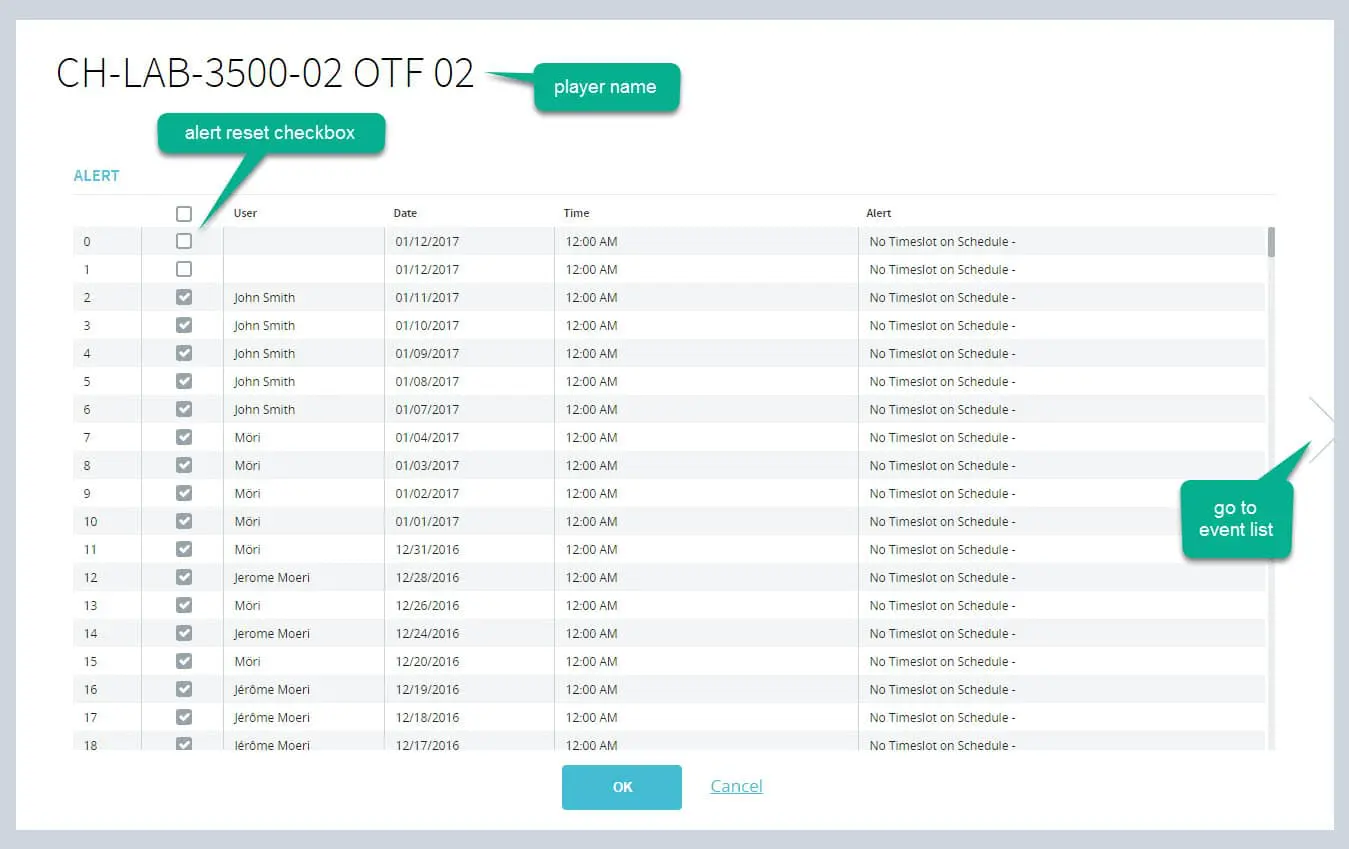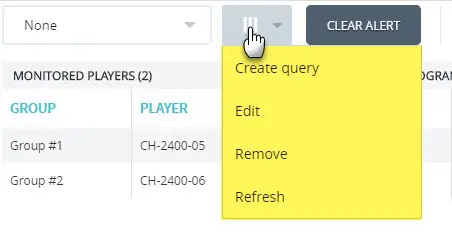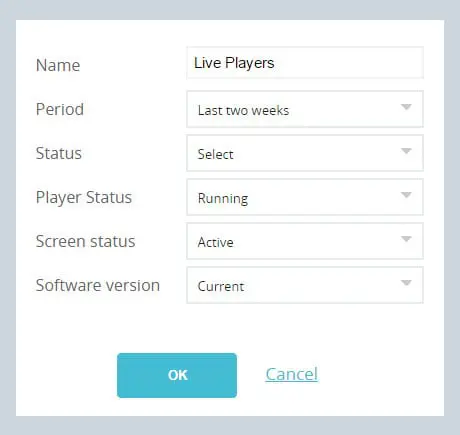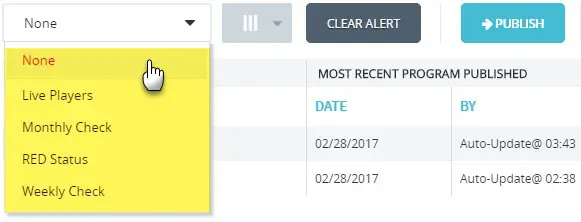Players can display 4 different status indicators (grey, blue, yellow or red).
Some status indicators will change automatically. For example, a new unassigned player licence status will change from grey to blue when the license has been activated and a player sends its first signal back to the server. Also, an online player that loses its network connection or is turned off will automatically change its status from blue to red. The cycle is reversed once the player gets back online and the status indicator switches back to blue.
Yellow alerts are the exception to the rule. A player status indicator turns yellow to announce an alert and once the indicator goes yellow, it will remain in that state until either the player is shut down / disconnected from the network or if the user resets (clears) the alert. Clearing a yellow alert restores the player to a blue state so this step should only be performed when the cause of the alert has been corrected.
Yellow alerts are triggered automatically when one of the following issue is detected:
- Player software has unexpectedly stopped.
- No content scheduled in the grid. The player is currently showing the default media.
- No data feed available.
- Player’s available free storage space is under its threshold.
- Player software has automatically restarted or the player has rebooted on its own to correct an issue (caused by depleted resources, for example).
- Content ignored – not playable (for example, unrecognized video codec or corrupt media file).
It’s important to note that many errors can be detected over time, while the player is displaying a yellow alert status. This is where the alert counter comes into play. The counter is shown in the monitoring window. It’s the column to the right of the status indicator.

Once the alerts are cleared, users see a blue status for all the players:

In the example above, the counter indicates there are 2 recorded alerts. These could be the same issue that has been detected twice or two different alerts. To find out more, click anywhere along the highlighted record. This will open the Alert and Event window.

Resetting Alerts
Yellow alerts can be reset in two different ways:
A) By clicking the Alert reset checkbox in the window above. You can select individual alerts or click the box at the top of the list to select them all.
B) Click OK or Cancel to return to the Monitoring window and click the Clear Alert button located left of the Publish button.

Note that clicking the Clear Alert button will reset all of the alerts. You must open the Alert and Event window to reset individual alerts.
Alert Queries
It’s easy to stay on top of the status of small networks, simply by selecting players and checking their status individually. However, LED VideoStar’s Monitoring window features a query system that makes it very easy to monitor the status large groups of players.
You can create custom alert queries that will filter search results. This lets you focus on the most urgent tasks.
You can create queries that will filter out all the selected players based on the following criteria:
- Time period: today, current week, last two weeks, last month, last quarter, last semester.
- Download status: Finished downloading content, currently downloading content.
- Player status: Player running (all blue and yellow status), blue status, yellow status, red status.
- Screen status: Active, inactive.
- Software version: current, previous version.
For example, you could have hundreds of players currently selected and filter out the list down to only players that have finished downloading their content and have a yellow status, and active screens.
To access the query menu, click the grey button left of CLEAR ALERT in the Monitoring window.

Available options are:
- Create query: lets you create a new query with the criteria of your choice.
- Edit query: modify an existing query.
- Remove query: delete a saved query.
- Refresh the list (left of the button).
Customize your query as needed then click OK to add it to the list.
NOTE: You don’t have to select all the options.

All saved queries show up in the pull down menu.

To reset the list and remove all queries, select option “None“.
Email Alerts
Users can automatically receive an email each time a player reports an alert. Emails will list the nature of the alert and include the name of any content that is triggering the error.
Here is a list of email alerts that are sent out by the server:
PLAYER OFFLINE (CODE: A-01-01)
This alert is sent out when a player is offline.
DOWNLOAD ERROR (CODE: A-01-02)
THIS ALERT IS SENT OUT WHEN A PLAYER HAS FAILED TO DOWNLOAD A FILE.
ABNORMAL TERMINATION (CODE: A-02-01)
This alert is sent out when a player has been shut down unexpectedly due to an unplanned PC/Android media player reboot or hardware crash.
NO TIMESLOT ON SCHEDULE (CODE: A-02-02)
This alert is sent out when a player has no programming scheduled for the current day or if the player has run out of programming
(exceeded the number of days without an update as per MENU > Tools > Player Technical Profile > Planning).
CONTENT PLAYBACK ERROR (CODE: A-02-03)
This alert is sent out when any content is skipped by a player because it could not be played
(for example: Player received a video file encoded with an unsupported codec so it skipped the item).
In order to send out email alerts, the server must be configured with a valid SMTP email account. Also, user accounts must include a valid email address. Lastly, the “send email” option must be enabled in the User Account settings.
What are Events?
Events are part of the normal, day to day operation of the player. Events don’t represent problems. In fact, events are recorded for future reference. Events are stored in the server’s database and users can view them by accessing the Alert and Event window.
Here is a list of events that can be recorded:
- Player has received a new program.
- Screen has been turned ON or OFF.
- Player software has been updated.
- Content is waiting to be approved.
What are Alert and Event Profiles?
Administrators control which type of alerts and events users can see and receive. For example, a IT specialist would require access to technical alerts and events. A person in charge of content requires access to content related alerts and events. This information is recorded in the user’s assigned alert and event profile. Administrators have total control over profiles and can even create custom profiles if required.
